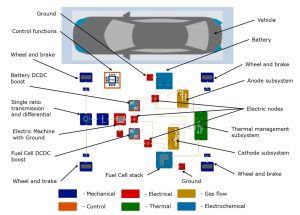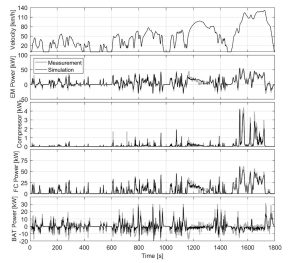Researchers of Laboratory of internal combustion engines and electromobility (LICeM) have developed and validated a high-fidelity multi-domain and multi-scale simulation model of a fuel cell electric vehicle, which is capable of modelling coupled phenomena from the vehicle level to intra-fuel cell level with a mechanistically based fuel cell model. Proposed approach represents a valuable contribution to the virtualisation of the system-level design of powertrains of fuel cell electric vehicles and supports front loading in the development process. The results were published in a renowned journal – Energy Conversion and Management (IF = 11.5).
Efficient virtual exploration of the design space represents one of the key objectives for cost and time efficient development and optimization of complex powertrains of electrified vehicles. To consistently model intertwined processes occurring in different domains and on different scales, proposed high-fidelity multi-domain and multi-scale model of a fuel cell electric vehicle is based on consistent coupling of different domains, which are: mechanical, electrical, electrochemical, gas flow, thermal, and control. These domains are modelled with mechanistic governing equations coupled to empirical degradation models of electrochemical devices. Establishing a consistent model based causal interactions between different domains and significantly different scales associated with underlying phenomena is crucial for more consistent virtual replication of phenomena in a real fuel cell electric vehicle. Such a model enables evaluating the impact of the parameters from high scales on intra-fuel cell spatiotemporal characteristics impacting fuel cell degradation. Presented results reveal very complex inter- and intra-domain interactions and their impact on performance and degradation of fuel cells and batteries confirming capability of the model to efficiently virtually explore and to optimize fuel cell electric powertrains from the intra-fuel cell to the vehicle level.

Figure 1: Simulated FCEV model topology and corresponding domains

Figure 2: Measurement and simulation data of electric machine, compressor, fuel cell, and battery power on the WLTC
Link to the paper: https://doi.org/10.1016/j.enconman.2022.116024